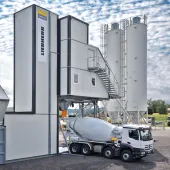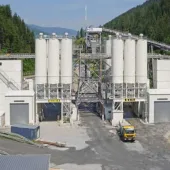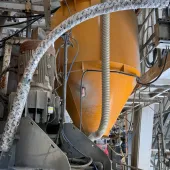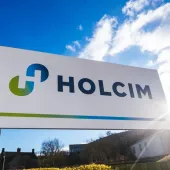The Development of Liebherr's Ring-Pan Concrete Mixer

First published in the December 2014 issue of Quarry Management as The Ring-Pan Mixer
Liebherr introduced their first ring-pan mixer some 60 years ago, heralding the start of what has become a huge success story for the German manufacturer
Liebherr-Mischtechnik GmbH commenced development and production of concrete mixing plants in Bad Schussenried, Germany, some 60 years ago. Over the intervening decades an extensive knowledge regarding concrete mixing technology has been gleaned, however, the company’s ring-pan mixer has stood out as one of the most significant products from the very beginning.
The mixer system is the heart of every concrete mixing plant; it is largely responsible for ultimate quality of the concrete. Premium mix results are not just left to chance, they are the consequence of numerous tests and experimentation. Liebherr ensured, more than 40 years ago, that they were in possession of their own testing facility (fig. 1), and today the company boasts a brand new, state-of-the-art test centre with concrete laboratory (fig. 2).
As well as extensive testing with various mixer types, this facility also allows the mixing of special concrete types (figs 3 & 4) in accordance with customers’ specific recipe requests. Experimentation with mixes is performed in the test centre with the customer present so that the mixer can be configured to precise customer requirements.
Liebherr ring-pan mixers are constructed in nominal sizes from 0.5m3 up to a maximum of 3.0m3. An agitator system is available as an option up to a nominal size of 1.5m3. Upwards of 1.5m3 the agitator system is included as standard, and a double agitator system is even possible as an alternative option. Ring-pan mixers featuring agitator systems are particularly well suited to the concrete goods and precast element industries. The high-grade concrete types used in these sectors, such as SCC (self-compacting concrete, see fig. 3) and UHPC (ultra-high-performance concrete, see fig. 4) necessitate intensive mixing procedures with high energy input.
Intensive mixing and short mix times
Homogenization is achieved via several individually configured mixing blades. The shape of the mixing blades ensures three-dimensional mixing of the product. A particular shape of ring channel forces the entire mix towards the mixing blades where it is thoroughly homogenized within a very short space of time. The blades move in a precisely defined vertical angle above the base of the trough. Material is lifted upwards and mixing is performed vertically. Blades set at different angles to the direction of transport distribute the material evenly in the horizontal plane. Scrapers are manoeuvred across the wall of the trough to convey the mix from the wall back towards the main agitator. This ensures movements of the material in all areas of the mixing trough.
The mixing trough has been specifically designed in diameter and height to guarantee three-dimensional mixing at all times, even with different filling amounts, whilst at the same time attaining as short a discharge time as possible.
The precisely co-ordinated arrangement of the mixing blades effects a transfer of energy to the aggregates in the middle, whereby friction between the stones lends an additional disaggregation of the cement. Quality of the mix is thus improved with less consumption of energy.
In addition to the mixing tools, an integrated agitator system contributes greatly to the development of cement lime, and therefore to mix quality. Installation of two agitators at varying distances to the main agitator will guarantee an even more intensive mixing procedure, as well as improved development of the cement lime, by providing an optimum cover for the ring channel. Extremely high agitator tool peripheral speeds prevent the formation of clumps and facilitate optimum disaggregation of the cement. Fines in the concrete are, therefore, more compact and the quality of the concrete is improved. Due to the high level of energy incorporated by the agitator in such a short space of time, high-strength concrete and special concrete can be mixed quicker and more thoroughly, thus ensuring more cost-effective production. This is particularly significant in factories manufacturing concrete goods as admixtures and colour pigments are often included here during production. The agitator system is designed to ensure exceptional results in such circumstances.
Exacting requirements for special concrete or high-performance concrete
An extremely thorough mixing of material is essential to attain a high mix quality of special concrete. Agitator tools featuring various shapes, sizes and number of rods, which are decisive for the respective mixer results, are available for diverse concrete recipes. The peripheral speed of the agitator tools is approximately 3m/s for transport concrete and may be increased to 18m/s for ultra-high performance concrete. Tools reinforced with carbide plates boast extremely low rates of wear.
A frequency converter allows the speed to be modified and adapted to the respective recipe during the mixing procedure. Thus, various speeds can be actuated for the filling process, for dry or wet mixes and for discharge. Regulation in accordance with the effective power of the motor is also possible.
SCC or UHFB concrete types (figs 5 & 6) are now being used much more frequently within the prefabricated elements sector. This type of concrete features lower water cement values and is liquefied with the introduction of admixtures. It is essential here that the concrete recipe, measuring of the water content for dry consistencies or monitoring of concrete flow properties is meticulously observed.
Flow properties can be reliably measured for ring-pan mixers by the motor output. The water content in the mixer is monitored with sensors. Regardless of whether these sensors are integrated in the base or whether they actually turn along with the mixing tools, the mixer has been designed to ensure the possibility of installing either Liebherr sensors or those from other manufacturers within the market. A hydraulically actuated sampling hatch allows samples of the mix to be extracted during the mixing process in order that properties of the fresh concrete can be checked.
Open design advantage
An expansive opening at the top of the trough (see lead image) allows an optimum and uncomplicated supply of materials to all Liebherr ring-pan mixers, including the new RIM 2.5 D, as well as unhindered access to the mixing gear. This design also facilitates quick and easy cleaning of the equipment. A large-sized mixer cover without accessories above the mixer allows an opening of between 30% and 60%, depending on the respective application. Uncomplicated access from above allowing for ease of maintenance is thus ensured. The gear and the drive motor are arranged beneath the mixer and are easily accessible, and sufficient space is provided in the upper area for dedusting and material supply components. Installation in various types of mixing plant is also simplified with this design.
Economization of cement, admixture and colouring pigments
Due to an ever-increasing need to accommodate the requirements for various concrete types, increasing numbers of admixtures are now being mixed into concrete. Extremely intensive mixing of these admixtures is essential for the attainment of exceptionally high-quality concrete. Recipes for special concrete in the concrete goods and precast element industries involve very low water-cement values; ie the respective water content is minimal. Large quantities of water and admixture are conveyed into the ring-pan mixer from above to ensure quick and even distribution. Special concrete features a lot of cement and fly ash, as well as large amounts of fines to produce a mix with high fines content. A combination of mixing blades and agitator attains excellent mix results in a very short space of time, even when using fine aggregates and minimal amounts of water. As a consequence of such thorough mixing and even distribution, approxmately 10% of cement, fly ash and admixture can be saved in certain concrete recipes, compared with other mixing systems. This signifies a cost reduction of almost €3 per cubic metre, or a saving of approximately €90,000 per year with an annual concrete production in excess of 30,000m3.
Shorter mix cycles due to speedy discharge
The special shape of the ring channel allows an optimum supply of material and ensures extremely short discharge times of only 20–40 seconds in combination with the blades. Mixing cycle times are therefore shorter and the output rate for the mixing plant is increased accordingly.
The hydraulic mixer gate delivers a swift and powerful closing action. Partial opening of the gate is also possible for smaller discharge volumes. Up to three mixer gates may be featured, eg to greatly facilitate flexible filling of bucket conveyers and truckmixers in combination.
Reduced contamination
The specific sequence in which the components are added prevents soiling. Water should be added last as a dedusting measure. As the water flows over the main agitator from above, cement dust is automatically washed into the ring channel. The agitator and mixing gear comprise a single unit featuring fewer edges on which deposits can accumulate.
Liebherr’s optional high-pressure cleaning system will guarantee quick and effective cleaning of the mixer, including the agitator tools and gates. Thus, cleaning by hand with a hose can be reduced to a minimum. Emptying of the cleaning water is assisted by the blades, in much the same way as the concrete. Extraction of residual water is therefore not necessary.
Equipped for the future
The optimal design and consistent subsequent development of the ring-pan mixer has remained a priority for Liebherr since conception of the company’s concrete technology range. Ongoing mixing tests with renowned customers from various product sectors in the concrete goods and prefabricated elements industries have demonstrated that the company’s ring-pan mixers are well designed for mixing even extremely sophisticated concrete types, both currently and in the future.
- Subscribe to Quarry Management, the monthly journal for the mineral products industry, to read articles before they appear on Agg-Net








